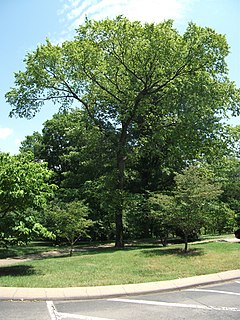
Ulmus crassifoliaNutt., the Texas cedar elm or simply cedar elm, is a deciduous tree native to south central North America, mainly in southern and eastern Texas, southern Oklahoma, Arkansas and Louisiana, with small populations in western Mississippi, southwest Tennessee and north central Florida; it also occurs in northeastern Mexico. It is the most common elm tree in Texas. The tree typically grows well in flat valley bottom areas referred to as 'Cedar Elm Flats'. The common name 'cedar elm' is derived from the trees' association with juniper trees, locally known as cedars.

Ulmus serotinaSarg., the September elm, is an autumn-flowering North American species of tree. It is uncommon beyond Tennessee; only very locally distributed through Illinois, Kentucky, Arkansas, Mississippi, Oklahoma, Alabama and Georgia, and disjunct into Nuevo León, Mexico. It grows predominantly on limestone bluffs and along streams to elevations of 400 m.
Beauprea crassifolia is a species of plant in the family Proteaceae. It is endemic to New Caledonia.
Glycosmis crassifolia is a species of plant in the family Rutaceae. It is a tree endemic to Peninsular Malaysia. It is threatened by habitat loss.

Oxera is a genus of flowering plants in the family Lamiaceae native to Vanuatu and New Caledonia in the western Pacific.
Rudgea crassifolia is a species of plant in the family Rubiaceae. It is endemic to Brazil. Its natural habitat is subtropical or tropical dry shrubland. It is threatened by habitat loss.
Maerua crassifolia is a species of plant in the Capparaceae family. It is native to Africa, tropical Arabia, and Israel, but is disappearing from Egypt. Foliage from this plant is used as fodder for animals, especially camels, during the dry season in parts of Africa.

The World's 25 Most Endangered Primates is a list of highly endangered primate species selected and published by the International Union for Conservation of Nature (IUCN) Species Survival Commission (SSC) Primate Specialist Group (PSG), the International Primatological Society (IPS), Global Wildlife Conservation (GWC), and Bristol Zoological Society (BZS). The IUCN/SSC PSG worked with Conservation International (CI) to start the list in 2000, but in 2002, during the 19th Congress of the International Primatological Society, primatologists reviewed and debated the list, resulting in the 2002–2004 revision and the endorsement of the IPS. The publication was a joint project between the three conservation organizations until the 2012–2014 list when BZS was added as a publisher. The 2018–2020 list was the first time Conservation International was not among the publishers, replaced instead by GWC. The list has been revised every two years following the biannual Congress of the IPS. Starting with the 2004–2006 report, the title changed to "Primates in Peril: The World's 25 Most Endangered Primates". That same year, the list began to provide information about each species, including their conservation status and the threats they face in the wild. The species text is written in collaboration with experts from the field, with 60 people contributing to the 2006–2008 report and 85 people contributing to the 2008–2010 report. The 2004–2006 and 2006–2008 reports were published in the IUCN/SSC PSG journal Primate Conservation,, since then they have been published as independent publications.
Oxera baladica is a species of flowering plant in the family Lamiaceae. It comprises two subspecies, both of which are included as vulnerable species on the IUCN Red List:





